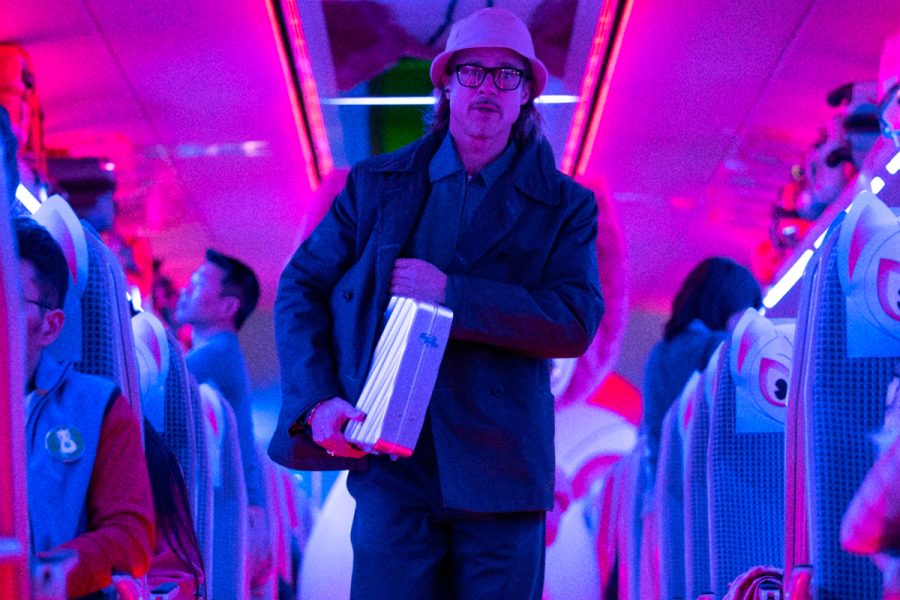“Bullet Train”: blood, banter…boring?
Brad Pitt and his fellow assassins find themselves entangled in a bloody battle to the death as they travel around in Tokyo’s famous bullet train.
Disclaimer: spoilers for the movie plot below.
Trailers advertised the star-studded film “Bullet Train” as a simple action-comedy about assassins — the film’s first mistake.
In this convoluted, rapid-fire adaptation of the novel “Maria Beetle,” by author Kotaro Isaka, the flashy special effects (SFX) and memorable cast of characters are unfortunately overshadowed by overdone Hollywood blood and gore. The thought and planning that went into the overarching story get swept aside in favor of grand theatrics and poor story proportioning, dooming a unique movie to succumb to SFX overuse.
Surprisingly, “Bullet Train” does not initially introduce its leading actor, instead spending the first five minutes focusing on Yuichi Kimura, a pivotal character played by Andrew Koji. We learn about his motivations as a desperate father, seeking to kill the person who pushed his son off a convenience store roof. Focusing on a side character allows the film to expand its world-building and strengthen on-screen relationships by telling the story through multiple narrators, a refreshing and creative move for such an anticipated film.
However, the somber tone of Kimura’s entrance clashes with the comedic introduction of the protagonist, Ladybug, a retired assassin played by Brad Pitt. The entrance is thrown in the audience’s face, a pattern that only gets amplified once the bloodshed begins. Minor details that develop the movie’s world-building, such as the characters’ symbolic titles, go ignored for a majority of the film in favor of distracting audiences with bright eye-catching fight scenes and close-up battles.
Because of these fast and catchy sequences, it cannot go unspoken that the premise itself is incredibly unique and enthralling. When the visceral fighting is put aside, there are moments that hint at the range and depth of the cast and their on-screen chemistry. Having such a diverse and wide range of characters with their individual backstories and motivations all organized in a way that doesn’t feel random is no small feat. However, the film does unfortunately condense these fascinating character stories to complete the overarching plot, and while “Bullet Train” does focus on the story, it feels like each character had so much more to offer, and interesting stories went sadly unexplored.
Sibling hitmen Lemon and Tangerine’s contrasting yet engaging interactions are a perfect example of underutilized character strengths. Lemon is the comic relief, comparing clients and targets to characters from the British kids show “Thomas the Train.” He contradicts his cynical brother Tangerine, a suave and spiteful assassin who despite his jaded presence is incredibly protective of his brother. Their chemistry is well-shown and prominent. However, for characters with such great acting and a unique dynamic, the endings they were given were spontaneous and held little closure. Tangerine’s death was bittersweet, because of the fact that he went out so quickly after believing that Lemon had been killed; it was rather frustrating for such an involved character to die suddenly with little conclusion to their arc. The potential of these two incredibly compelling characters is lost due to a lack of proper screen time to develop, and left an unsatisfying conclusion to their stories.
Shortly after an ending that was incredibly reflective and conclusive, the movie inserts more poorly timed comedy in Lemon’s final act for his brother. He ends up murdering Tangerine’s killer, but it came long after the story had concluded as a “bonus scene.” The moment lost all gravity by putting him back into comic relief and having Lemon run the killer over with a Tangerine fruit truck. The repeated contrast of serious plot juxtapositioned with physical comedy works in the story’s favor only half of the time, quickly turning to whiplash and affecting the quality of the narrative.
Even the finale of the film is not exempt from this pattern, which loses meaning and depth after the prolonged cuts between two very different battles on the train. The guns and knives used in on-screen conflicts feel cluttered in comparison to the final confrontation. While Kimura and his father The Elder are engaged in a fierce battle, Ladybug is stuck fighting with a mishmash of train pamphlets and fire extinguishers. It felt like a poor choice of choreography given the majestic finale and played right into the film’s recurring issue of pacing their theme. This could have been fixed if Ladybug had been less of a focus, like at the beginning of the movie, and allowed the plot a well-needed pause from the graphic bloodshed. Nonetheless, Ladybug did have considerably less involvement in the climactic conclusion than in other plot points, allowing for his newfound allies to fight Yakuza boss White Death. The two pay homage to Japanese culture with a magnificent sword fight, breaking the archetype of the lead actor in a foreign country dealing the final blow to the antagonist, and allowing for a respectful conclusion that leaves audiences on the edge of their seats.
For a movie that prided itself on such a diverse and versatile cast, they were pushed aside by the excess of gore and this cheapened the impact of their stories. While the introduction was eye-catching, the film got lost in the dismemberment and short-lived cast of characters. The relationships shown are meaningful, and the casting felt right, but there was a lack of experimentation with how the plot could’ve been portrayed. For a beautiful tale of intrigue and mystery, the only intrigue that stood out was the choice of special effects.




